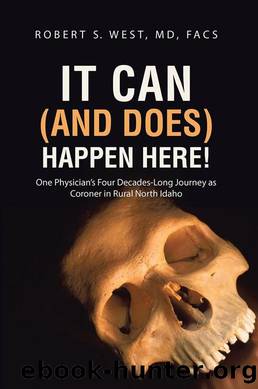It Can (and Does) Happen Here! by Robert S. West MD FACS

Author:Robert S. West, MD, FACS [Robert S. West, MD, FACS]
Language: eng
Format: epub
ISBN: 9781458215420
Publisher: AbbottPress
Published: 2014-05-09T00:00:00+00:00
CHAPTER 12
THE ENVIRONMENT IS ALWAYS AROUND US
North Idaho and the Rathdrum Prairie have an ideal climate and topography for the cultivation of bluegrass seed used in lawns and golf courses around the world. Thousands of acres of bluegrass fields stretch from Sandpoint to Plummer, Idaho, and into Washington State. Plentiful water for irrigation is necessary for the bluegrass to mature. Massive combines thresh the seeds, which are then transported to processing facilities.
The Jacklin Seed Company sorts, separates, and stores thousands of tons of bluegrass seed at its plant in Post Falls. This is marketed worldwide to consumers, including golf courses and homeowners.
One of the cultivation methods used to ensure a vigorous fall growth of the plants is to burn the stubble fields in the fall. This stimulates the plants to send down root systems, which then produce more and better seed the following season. The process also eliminates noxious weed seeds in the bluegrass fields.
The field burning in August and September uses a meteorological forecast of temperatures and wind conditions to allow the grass farmers to set thousands of acres of bluegrass stubble aflame. Smoke billowing to several thousand feet is a startling sight in country where most smoke can only mean one thing: forest fires. For the majority of field burning, the forecasts on burn days have allowed the smoke to dissipate away from population centers with minimal disruption in peopleâs daily lives.
In other cases, an inversion holds the cloud of smoke at the surface, producing a choking, throat burning irritating environment, which can produce severe symptoms, especially in persons with respiratory diseases such as asthma or chronic obstructive pulmonary disease. These patients are told to stay indoors and avoid excessive exposure to the smoke. Clean Air advocates began to agitate against the field burning in the late 1970s. They formed an advocacy group, SAFE (Safe Air for Everyone,) to focus their efforts and produce changes in the tilling methods.
M.M. was a breast cancer survivor patient of mine who worked as a waitress in Rathdrum. We had to manage her asthma very carefully during her surgery and recovery. My medical colleagues managed her asthma and were of great help in that respect. As the field-burning season approached, M.M would frequently call to have her asthma medications filled or her home nebulizer refilled.
One evening after the dayâs field burning had subsided, a pall of smoke descended over Rathdrum, restricting visibility for drivers and causing severe symptoms to many patients. M.M stayed indoors and did not show up for her waitress job. She developed respiratory distress in the early evening hours. She called 911, and an ambulance was dispatched to her home. When they arrived, M.M. was deceased on a couch in the living room. Her nebulizer was still running and other asthma medications sat on a table near her. The paramedics were unable to resuscitate her.
At autopsy, her lungs were hyperaerated, extending across the midline from both thoracic cavities. The bronchiospasm induced by the air pollution prevented air from being exhaled and the lungs became hyper-inflated.
Download
This site does not store any files on its server. We only index and link to content provided by other sites. Please contact the content providers to delete copyright contents if any and email us, we'll remove relevant links or contents immediately.
Sapiens: A Brief History of Humankind by Yuval Noah Harari(13086)
The Tidewater Tales by John Barth(12040)
Do No Harm Stories of Life, Death and Brain Surgery by Henry Marsh(6345)
Mastermind: How to Think Like Sherlock Holmes by Maria Konnikova(6259)
The Thirst by Nesbo Jo(5802)
Why We Sleep: Unlocking the Power of Sleep and Dreams by Matthew Walker(5667)
Sapiens by Yuval Noah Harari(4560)
Life 3.0: Being Human in the Age of Artificial Intelligence by Tegmark Max(4525)
The Longevity Diet by Valter Longo(4458)
The Rules Do Not Apply by Ariel Levy(3920)
The Immortal Life of Henrietta Lacks by Rebecca Skloot(3835)
The Body: A Guide for Occupants by Bill Bryson(3828)
Why We Sleep by Matthew Walker(3783)
Animal Frequency by Melissa Alvarez(3764)
Yoga Anatomy by Kaminoff Leslie(3716)
Barron's AP Biology by Goldberg M.S. Deborah T(3640)
The Hacking of the American Mind by Robert H. Lustig(3590)
All Creatures Great and Small by James Herriot(3530)
Yoga Anatomy by Leslie Kaminoff & Amy Matthews(3410)
